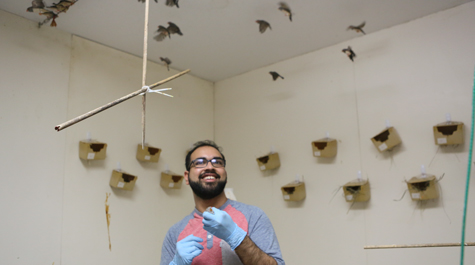At the Graduate Research Symposium: Effects of mercury on the sperm of songbirds
A grasp of the differences between the “birds and the bees” as practiced by humans and the reproduction of actual birds and bees is necessary to understand Ananda Menon’s research. Especially the birds.
Menon is pursuing a master’s degree in William & Mary’s Department of Biology. His thesis project involves an examination of the effects of mercury on the sperm of birds. The work was awarded one of two Interdisciplinary Research Awards in conjunction with the 16th Annual Graduate Studies Research Symposium to be held at William & Mary’s Sadler Center March 24-25.
Menon’s research is part of an expanding suite of research on the effects of mercury on birds at the university, the core of which is work by Professor Dan Cristol and Menon’s advisor, Professor John Swaddle.
Mercury is a persistent and common environmental pollutant. Menon cites figures indicating that some 1,965 tons of mercury were released into the environment in 2010 alone. Once mercury becomes methylated — processed by bacteria, it works its way up through aquatic and terrestrial food webs.
 Both animals and humans ingest mercury in food and it can cause a number of problems in wildlife, domestic animals and humans. There are a number of well-known mercury-caused ailments, but the effects of mercury on sperm cells are just beginning to be investigated.
Both animals and humans ingest mercury in food and it can cause a number of problems in wildlife, domestic animals and humans. There are a number of well-known mercury-caused ailments, but the effects of mercury on sperm cells are just beginning to be investigated.
“There is a lot of evidence that mercury is toxic to sperm,” Menon said. “Selenium is a very important element in many enzymes involved in making sperm. And mercury really likes to bind to selenium, chemically. It can inactivate spermatogenesis, the process of making sperm.”
Menon’s work involves comparing the sperm produced by a group of zebra finches whose food has been dosed with mercury with an undosed control group of birds. He will collect sperm using a couple of techniques. He also is able to extract sperm from eggs laid by females.
Zebra finches are passerines, perching birds in the same class of our familiar songbirds. An understanding of Menon’s work requires some background about the passerine facts of life, which contain some distinct departures from the realities of human reproduction.
“First of all,” Menon said, “birds don’t have a penis.”
He explained that like most birds — and all passerines — male and female zebra finches each have a multipurpose urinal-genital orifice, a cloaca. Copulation is performed by the birds maneuvering their cloacae into a “cloacal kiss,” a brief, blissful adjacency during which the sperm is transferred from the male’s cloaca into the female’s.
Another difference from humans is that a healthy songbird is always somewhere on a breeding cycle.
“It’s like they are continually going from puberty to fertility to menopause,” Menon explained. “There is no menstrual cycle for birds. They do this over and over again.”
And the males have a cycle, too. The male version of this breeding cycle is more complex than what happens with humans. As a bird breeding cycle ramps up, their internal testes grow to several times their non-breeding size. After breeding, they shrink to insignificance, waiting dormant for the cycle to begin again. When bird testes are up and running, their product is quite different in appearance from the big-headed, stretched-tadpole shape of human spermatozoa.
“Human sperm is really less exciting than bird sperm. Bird sperm is really funky-looking. It has this kind of corkscrew-shaped head,” Menon said.
Bird sperm cells even behave differently than their human counterparts, he added. The bird cells might race each other for a bit, or they might clump together.
“There is a lot of variation among the sperm cells, too: You can have long heads and short tails, or long tails and short heads, ” he added.
A healthy male zebra finch will ejaculate in the neighborhood of 8 million funky-looking sperm cells, Menon said. Only 15 to 30 of these swimmers will reach the ovum, and that’s where there’s another set of departures from mammalian reproduction.
He said that unlike mammals, birds only have one ovary. A more important difference for Menon’s research is what happens to the bird sperm that reach the ovum, but don’t fertilize it.
“The extra sperm, they get caught in the membrane that surrounds the ovum,” he said. Those just-missed-the-bullseye sperm are trapped, held intact. When the female lays her eggs, Menon can recover the sperm it contains — but not the sperm cell that actually did the fertilizing.
“Basically, I can dissect an egg and there’s membrane around the yolk and get a really accurate measure of how many sperm reach the egg,” he said. It’s one aspect of the study that would be impossible to do with mammals — without killing the mother.
For all the differences between birds and mammals, Manon points out that the similarities are more important when considering what studies such as his could suggest about the effects of mercury on human sperm, a topic that he believes has been under-studied in the past 20 years..
“At the end of the day, birds and mammals aren’t that different,” he said. “Mercury has been linked to a large number of human males as well. ”
In late February, Menon was designing ways to measure differences in sperm quality among his mercury-dosed birds and the control group. He will compare sperm count, presence of defective sperm and differences in characteristics.
“You can understand that I can’t look at millions of cells,” he said. “So I have to develop techniques to do that.”
Manon explained he will use two techniques to collect sperm from his male birds. The first is straightforward: He can express sperm manually from the cloaca of a ready-to-breed finch.
“You can just squeeze a little bit out,” he said. “And this is the standard technique that’s been used. But birds invest in sperm differently, and using this artificial technique may not give us the best picture.”
He explained that a bird’s “investment” in sperm depends on a number of environmental factors. For one thing, birds create more sperm when more male birds are in the immediate vicinity. Menon also says he wants to compare sperm from actual, or at least simulated, breeding.
To collect sperm produced under the nearest thing possible to breeding conditions, he will deploy a flock of female manikin birds.
“What I do is I take a female bird that has died of natural causes here in the aviary, then I actually freeze-dry the female. Fortunately, birds are mostly fluff, so the body shrinks when it’s freeze-dried, but the feathers don’t let that show,” Menon explained.
It takes four or five days of freeze drying to desiccate a lady finch sufficiently so that she doesn’t start to stink up the aviary. Menon removes the cloaca and replaces it with a condom-like device to collect the sperm.
“Then I pose her as if she is in a mating position,” he said.
The come-hither pose is an obvious and necessary aspect of allure, but Menon has to take care how he accessorizes his ladies. Finches have their own mysterious set of attraction do’s and don’ts. For example, one reliable turn-off for a male zebra finch is a female wearing a blue leg band, he said.
“If the artificial collection doesn’t show anything, but the ‘natural’ one does, I’ll know that they are investing differently,” he said. “That would be an interesting finding in and of itself.”














